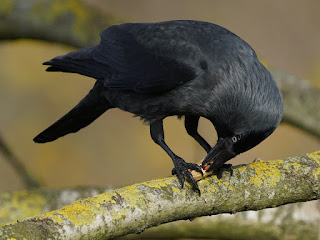Another windy day. The Pied Wagtails at the Round Pond like to hunt in the pools left by waves breaking over the edge, where edible creatures get washed ashore. In the last shot I was being so buffeted by the wind that I couldn't hold the camera steady.
The newest Coal Tit in the Flower Walk was in a nervous mood and it took several minutes before it would come down to my hand.
A Long-Tailed Tit paused for a moment on a bramble growing up through the yew tree north of Peter Pan.
Ahmet Amerikali found three Goldcrests in the yew across the path in the leaf yard.
Both Peregrines were on the tower, but they kept disappearing as they went to the back of the ledge to get out of the wind.
One of the new group of Jackdaws on the south side of the Serpentine skilfully shelled a peanut.
The pigeon-eating Lesser Black-Backed Gull had had his breakfast and was tolerantly letting a couple of Carrion Crows finish the scanty leftovers.
People throw strange things into the lake believing that the birds will eat them. This young Herring Gull found a spring onion, which it didn't like at all and quickly dropped.
One of this pair of displaying Black-Headed Gulls has an orange plastic ring, 2V37. Ring codes beginning with 2 are British. A few days ago I saw 2V40, and. I was wondering whether they were put on by Bill Haines, but all his other rings to date have been white. Oddly, there is no information about this series on the colour ring recording site at cr-birding.org -- I tried both red and orange here as it's often hard to distinguish them, but neither produced a result.
The newly arrived Great Crested Grebes are still in a compact group. It takes several days for them to separate into pairs and start claiming a territory.
The fifth one had gone over the southeast corner of the Serpentine to fish.
The attempt by the new pair of Mute Swans to settle on the Long Water seems to have failed. They were neither there nor in the Italian Garden today, and there was nothing but a Grey Heron on the nesting island.
Then the dominant pair returned from their empire-building expedition on the Serpentine. In the second shot you can see the female's orange leg ring 4DBE.
A hoverfly, Eupeodes luniger, settled on the leaf of a box holly bush in the Rose Garden. I chose this picture because it shows the pretty iridescence on its crossed wings, but these conceal the pairs of yellow crescent moon marks that give it is name.
The recent mild weather has started bulbs sprouting prematurely in the Rose Garden. I think these are crocuses, but it's hard to tell at this stage.


%202022%201a.jpg)


%20letting%20crows%20eat%20leftovers%202022%201a.jpg)







I shudder to think what a Napoleon complex may look like in a swan.
ReplyDeleteIt's incredible how such slight things as Wagtails are can hold their own against the wind without apparent effort, when we barely can.
Tinúviel
I suppose the Pied Wagtail one the ground is less affected by the wind than a human, as the air moves more slowly there. Also it's holding on with its claws. But at one point in the video it does get blown off its feet.
Delete